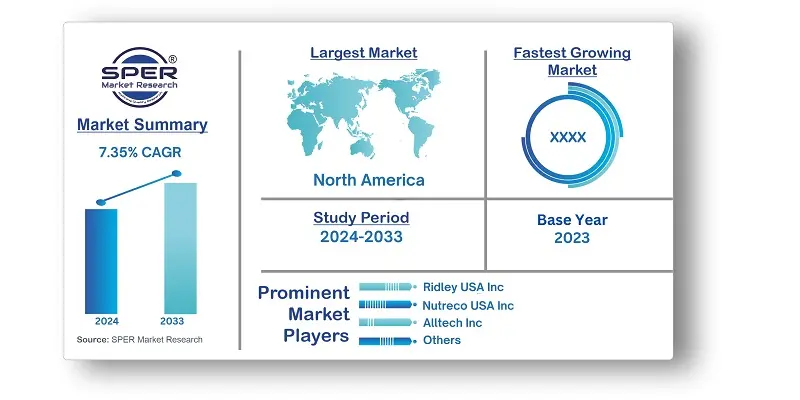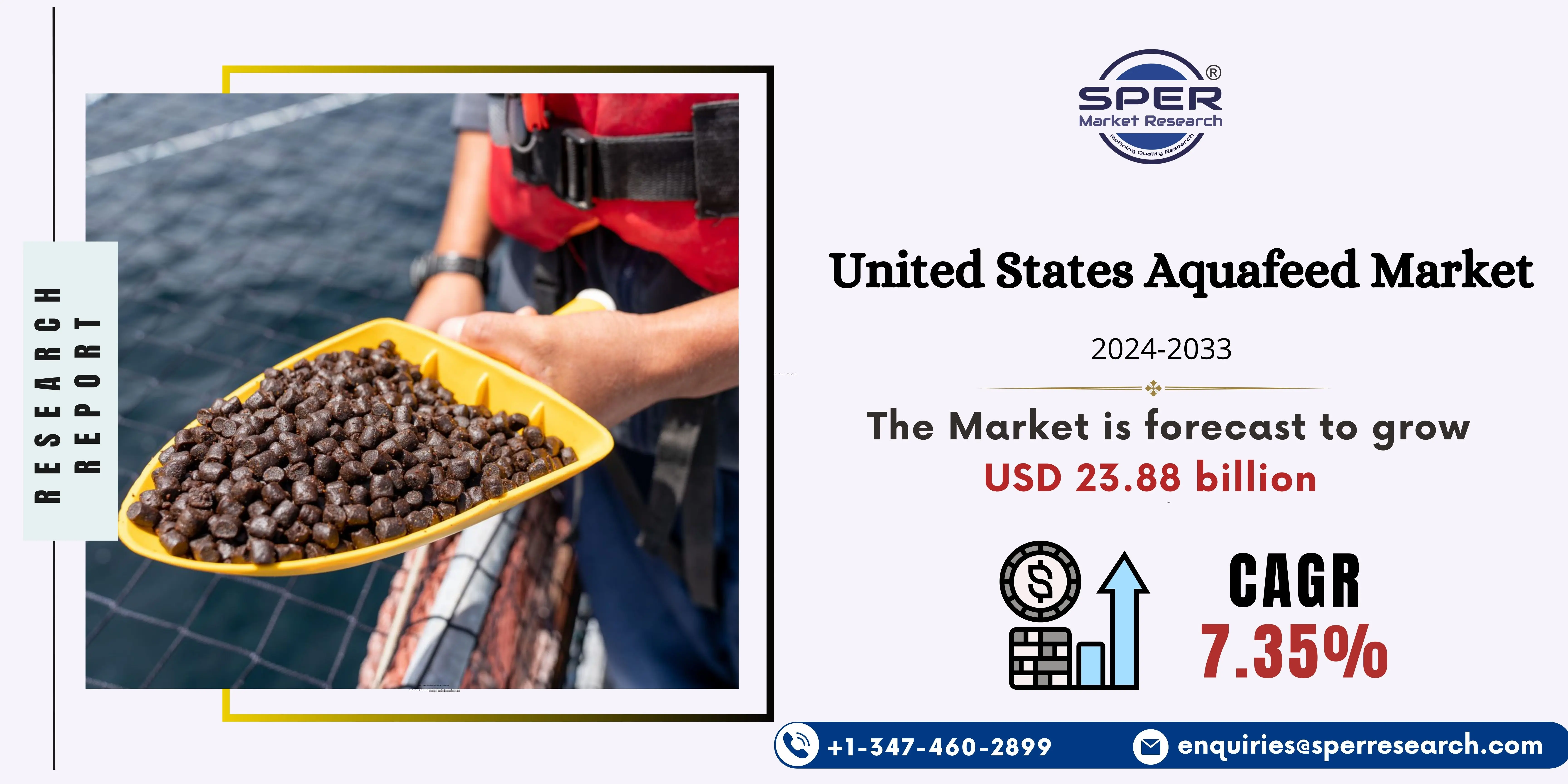
United States Aquafeed Market Growth, Size, Trends, Demand, Share, Revenue and Future Outlook
United States Aquafeed Market Size- By Ingredient, By Additives, By Species, By Product Form- Regional Outlook, Competitive Strategies and Segment Forecast to 2033
| Published: May-2024 | Report ID: FOOD2457 | Pages: 1 - 102 | Formats*: |
| Category : Food & Beverages | |||
- Skretting and BioMar established a partnership in July 2023 to create new sustainable and nutritious aquafeed components, with an emphasis on alternative protein sources such as insect meal and algae.
- In June 2021, ADM plans to extend its aquaculture enterprises and manufacturing capabilities in China by introducing Life Defense and Ocialis fish and shrimp feeds to the market.
- In June 2021, S2G Ventures invested $100 billion in ocean and seafood enterprises. The corporation has released the names of the first five companies to which it has made payments: ReelData, ViAqua Therapeutics, Moleaer, and the names of the last two companies were not disclosed.


| Report Metric | Details |
| Market size available for years | 2020-2033 |
| Base year considered | 2023 |
| Forecast period | 2024-2033 |
| Segments covered | By Ingredient, By Additives, By Species, By Product Form |
| Regions covered | West United States, East United States, North United States, South United States |
| Companies Covered | The Archer Daniels Midland Company, Ridley USA Inc, Cargill Animal Nutrition, Nutreco USA Inc, Alltech Inc, Nutraid USA, Novus International Inc, Skretting AS, Purina Animal Nutrition, Charoen Pokphand USA Inc. |
- Aquaculture Farmers
- Aquaculture Feed Distributors
- Aquaculture Researchers and Scientists
- Feed Manufacturers
- Government and Regulatory Bodies
- Investors and Financial Institutions
- Pet Food Manufacturers
- Research and Development Institutions
- Retailers and Wholesalers
- Veterinarians and Nutritionists
| By Ingredient: |
|
| By Additives: |
|
| By Species: |
|
| By Product Form: |
|
- United States Aquafeed Market Size (FY’2024-FY’2033)
- Overview of United States Aquafeed Market
- Segmentation of United States Aquafeed Market By Ingredient (Soybean, Fish Meal, Corn, Fish Oil, Additives, Others)
- Segmentation of United States Aquafeed Market By Additives (Amino Acids, Vitamins & Minerals, Prebiotics & Probiotics, Enzymes, Antibiotics, Others)
- Segmentation of United States Aquafeed Market By Species (Carps, Marine Shrimps, Tilapias, Catfishes, Marine Fishes, Salmons, Freshwater Crustaceans, Trout, Others)
- Segmentation of United States Aquafeed Market By Product Form (Pellets, Extruded, Powdered, Liquid)
- Statistical Snap of United States Aquafeed Market
- Expansion Analysis of United States Aquafeed Market
- Problems and Obstacles in United States Aquafeed Market
- Competitive Landscape in the United States Aquafeed Market
- Impact of COVID-19 and Demonetization on United States Aquafeed Market
- Details on Current Investment in United States Aquafeed Market
- Competitive Analysis of United States Aquafeed Market
- Prominent Players in the United States Aquafeed Market
- SWOT Analysis of United States Aquafeed Market
- United States Aquafeed Market Future Outlook and Projections (FY’2024-FY’2033)
- Recommendations from Analyst
1.1. Scope of the report1.2. Market segment analysis
2.1. Research data source2.1.1. Secondary Data2.1.2. Primary Data2.1.3. SPER’s internal database2.1.4. Premium insight from KOL’s2.2. Market size estimation2.2.1. Top-down and Bottom-up approach2.3. Data triangulation
4.1. Driver, Restraint, Opportunity and Challenges analysis4.1.1. Drivers4.1.2. Restraints4.1.3. Opportunities4.1.4. Challenges4.2. COVID-19 Impacts of the United States Aquafeed Market.
5.1. SWOT Analysis5.1.1. Strengths5.1.2. Weaknesses5.1.3. Opportunities5.1.4. Threats5.2. PESTEL Analysis5.2.1. Political Landscape5.2.2. Economic Landscape5.2.3. Social Landscape5.2.4. Technological Landscape5.2.5. Environmental Landscape5.2.6. Legal Landscape5.3. PORTER’s Five Forces5.3.1. Bargaining power of suppliers5.3.2. Bargaining power of buyers5.3.3. Threat of Substitute5.3.4. Threat of new entrant5.3.5. Competitive rivalry5.4. Heat Map Analysis
6.1. United States Aquafeed Market Manufacturing Base Distribution, Sales Area, Product Type6.2. Mergers & Acquisitions, Partnerships, Product Launch, and Collaboration in United States Aquafeed Market
7.1. United States Aquafeed Market Size, Share and Forecast, By Ingredient, 2020-20267.2. United States Aquafeed Market Size, Share and Forecast, By Ingredient, 2027-20337.3. Soybean7.4. Fish Meal7.5. Corn7.6. Fish Oil7.7. Additives7.8. Others
8.1. United States Aquafeed Market Size, Share and Forecast, By Additives, 2020-20268.2. United States Aquafeed Market Size, Share and Forecast, By Additives, 2027-20338.3. Amino Acids8.4. Vitamins & Minerals8.5. Prebiotics & Probiotics8.6. Enzymes8.7. Antibiotics8.8. Other
9.1. United States Aquafeed Market Size, Share and Forecast, By Species, 2020-20269.2. United States Aquafeed Market Size, Share and Forecast, By Species, 2027-20339.3. Carps9.4. Marine Shrimps9.5. Tilapias9.6. Catfish9.7. Marine Fishes9.8. Salmons9.9. Freshwater Crustaceans9.10. Trout9.11. Others
10.1. United States Aquafeed Market Size, Share and Forecast, By Product Form, 2020-202610.2. United States Aquafeed Market Size, Share and Forecast, By Product Form, 2027-203310.3. Pellets10.4. Extruded10.5. Powdered10.6. Liquid10.7. Others
11.1. United States Aquafeed Market Size and Market Share
12.1. United States Aquafeed Market Size and Market Share By Region (2020-2026)12.2. United States Aquafeed Market Size and Market Share By Region (2027-2033)12.3. West United States12.4. East United States12.5. North United States12.6. South United States
13.1. The Archer Daniels Midland Company13.1.1. Company details13.1.2. Financial outlook13.1.3. Product summary13.1.4. Recent developments13.2. Ridley USA Inc13.2.1. Company details13.2.2. Financial outlook13.2.3. Product summary13.2.4. Recent developments13.3. Cargill Animal Nutrition13.3.1. Company details13.3.2. Financial outlook13.3.3. Product summary13.3.4. Recent developments13.4. Nutreco USA Inc13.4.1. Company details13.4.2. Financial outlook13.4.3. Product summary13.4.4. Recent developments13.5. Alltech Inc13.5.1. Company details13.5.2. Financial outlook13.5.3. Product summary13.5.4. Recent developments13.6. Nutraid USA13.6.1. Company details13.6.2. Financial outlook13.6.3. Product summary13.6.4. Recent developments13.7. Novus International Inc13.7.1. Company details13.7.2. Financial outlook13.7.3. Product summary13.7.4. Recent developments13.8. Skretting AS13.8.1. Company details13.8.2. Financial outlook13.8.3. Product summary13.8.4. Recent developments13.9. Purina Animal Nutrition13.9.1. Company details13.9.2. Financial outlook13.9.3. Product summary13.9.4. Recent developments13.10. Charoen Pokphand USA Inc13.10.1. Company details13.10.2. Financial outlook13.10.3. Product summary13.10.4. Recent developments13.11. Others
SPER Market Research’s methodology uses great emphasis on primary research to ensure that the market intelligence insights are up to date, reliable and accurate. Primary interviews are done with players involved in each phase of a supply chain to analyze the market forecasting. The secondary research method is used to help you fully understand how the future markets and the spending patterns look likes.
The report is based on in-depth qualitative and quantitative analysis of the Product Market. The quantitative analysis involves the application of various projection and sampling techniques. The qualitative analysis involves primary interviews, surveys, and vendor briefings. The data gathered as a result of these processes are validated through experts opinion. Our research methodology entails an ideal mixture of primary and secondary initiatives.



Frequently Asked Questions About This Report
PLACE AN ORDER
Year End Discount
Sample Report
Pre-Purchase Inquiry
NEED CUSTOMIZATION?
Request CustomizationCALL OR EMAIL US
100% Secure Payment






Related Reports
Our Global Clients
Our data-driven insights have influenced the strategy of 200+ reputed companies across the globe.




















